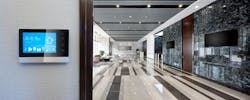Wireless Thermostats Provide Cost-Effective Upgrade for Pneumatic Controls
Are your building’s pneumatic HVAC controls beginning to feel like old clunkers compared to flashy digital controls? If so, an upgrade with wireless pneumatic thermostats (WPTs) may usher your building into the modern age while reducing energy costs. According to a study of a WPT installation at a GSA office building, the return on investment for such upgrades can be as low as two years.
Both conventional pneumatic thermostats and WPTs have space temperature sensors and the ability to send informa-tion via the existing pneumatic tubing. However, the WPT devices have a wireless connection to a central energy management system (EMS). As a result, building managers can implement energy-saving strategies, such as adjusting setpoints for weekends and holidays. Lacking a wireless connection, conventional thermostats can only have their setpoints adjusted manually by someone at the device. Converting such thermostats to direct digital controls (DDC) is typically cost prohibitive.
Energy Saving Plan: Consider Occupant Comfort
Pneumatic controls are typically found in multi-story buildings built before 1999 and containing more than 20,000 square feet. Buildings of this size are likely to have central plants with zone thermostat controls, while smaller buildings tend to rely on rooftop or packaged units that directly serve the space below or adjacent to the unit. Within GSA’s portfolio, some 20% of the buildings have HVAC systems operated by pneumatic controls, and all of them are subject to the same energy mandates as all other federal buildings.
Smart Sensor Technology: Reducing HVAC Energy Use
This mix is typical of the majority of facilities in GSA’s portfolio. With no secure areas that were off limits, researchers were free to install data loggers and take measurements in all areas.
The results of the installation at the WWC were used as the basis for computer modeling of the potential energy savings in small (5,500 square feet), medium (53,630 square feet) and large office buildings (498,500 square feet) in 16 climate zones across the U.S.
Estimated Savings from WPT Implementation
The research concludes that retrofitting with WPTs is an economically viable best practice for GSA in all climate zones and building sizes. The technology is commercially available and the hardware has a projected life of more than 10 years. Installation estimates ranged from 50 cents to $1.20 per square foot (see box).
Small office buildings offer the shortest estimated paybacks at an average of 4.3 years across all climate zones, while medium and large office buildings were estimated to have average paybacks of 6.3 and 5.5 years respectively. The estimated savings were based on the simplest occupied/unoccupied setpoint schedules. Researchers believe that more sophisticated scheduling strategies would produce larger savings.
67 Money-Saving Products for 2018
Caveats for implementation include determining how well wireless signals travel through a building because construction type and materials affect signal transmission. Also, some training is required for operators.
For more information on the estimated savings for the three office types in specific climate zones, see Wireless Pneumatic Thermostat Evaluation: Ronald Reagan Building and International Trade Center at www.gsa.gov.
Estimated Costs for Installing Wireless Pneumatic Thermostats
- Small office: (5,500 ft2) × ($0.70 to $1.20 per ft2) = $3,850 to $6,600 installed cost.
- Medium office: (53,630 ft2) × ($0.60 to $1.10 per ft2) = $32,200 to $59,000 installed cost.
- Large office: (498,500 ft2) × ($0.50 to $0.90 per ft2) = $249,000 to $449,000 installed cost.
Source: Wireless Pneumatic Thermostat Evaluation: Ronald Reagan Building and International Trade Center, a report prepared for GSA by the Oak Ridge National Laboratory
